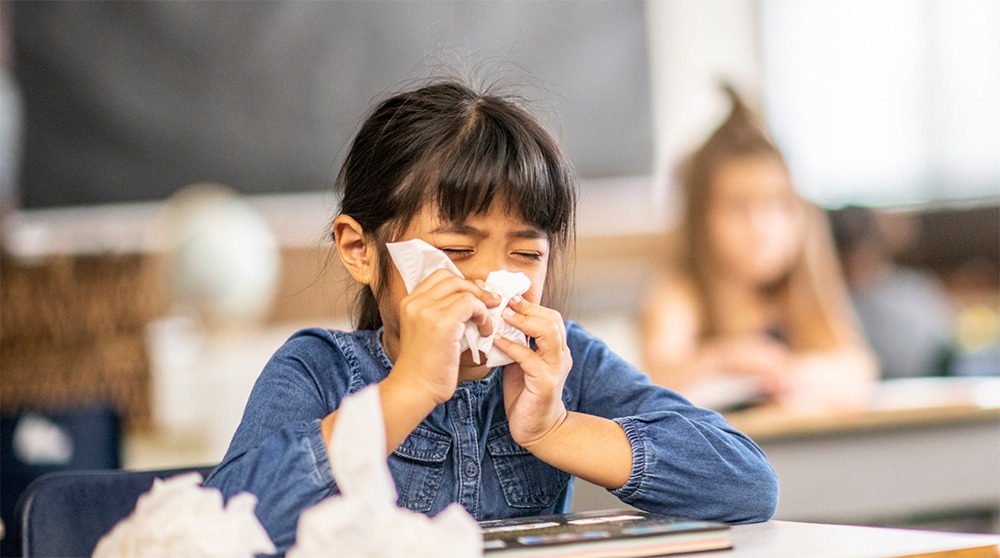Back-to-School Season, a Period of Illnesses for Children
To better understand the health risks to children from their daily interactions in school, and to learn what are some of the preventive measures that students, teachers, and parents can cultivate to promote good health and hygiene, we spoke to the World Health Organization (WHO) representative in Kuwait, Dr, Assad Hafeez.

Back-to-school season is a time marked by a dramatic increase in many illnesses among children such as influenza (flu), the common cold, strep throat, diarrhea, and conjunctivitis. The main reason for children to catch illnesses at school is their close proximity with other students in the classroom, and the potential for germs to spread quickly through the school environment.
To better understand the health risks to children from their daily interactions in school, and to learn what are some of the preventive measures that students, teachers, and parents can cultivate to promote good health and hygiene, we spoke to the World Health Organization (WHO) representative in Kuwait, Dr, Assad Hafeez.
During the interview, Dr. Hafeez highlighted the importance of personal hygiene among students to prevent the spread of germs, and the critical role that teachers and parents play in ensuring that children stay healthy while at school and at home.
What are the most common infectious diseases that tend to increase during the back-to-school season?
“When schools reopen, it’s almost as if the germs head back to class too. The most common illnesses we see are colds, flu, COVID-19, respiratory syncytial virus (RSV), hand, foot, and mouth disease (especially among younger children) and acute watery diarrhea.
“While none of these are unusual, the close contact and shared spaces in schools mean these illnesses can spread quickly, making it important to encourage good hygiene and early care to keep children healthy.”
How do these diseases typically spread?
“Most of these illnesses spread through everyday interactions—coughing, sneezing, or touching surfaces with unwashed hands and then touching the face. Even sharing simple items like a water bottle or borrowing a pencil can be enough to pass germs along.
“Children are naturally social, and while that closeness is a wonderful part of growing up, it also gives viruses an easy way to travel. Unfortunately, when kids bring these germs home, they can unintentionally spread them to more vulnerable family members, such as grandparents or those with weakened immune systems.”
What early warning signs should parents and teachers look out for?
“I always say: trust your instincts. If a child seems more tired than usual, has a fever, a persistent cough, or keeps complaining of a sore throat or stomach pain, those are red flags.
“It’s best to keep them home early rather than risk the illness getting worse—or spreading to the whole class. Schools should also have a clear plan for separating sick students from healthy ones without causing stigma, and for notifying parents or health care providers when needed.”
What role can students themselves play in prevention and protecting their classmates?
“Children love being health heroes, and with the right guidance, they can play a big role in keeping their schools and families safe. Even the simplest habits can make a huge difference. Teaching kids to wash their hands before eating and after using the toilet, use hand sanitizer when soap and water aren’t available, and cough or sneeze into their elbows instead of their hands helps stop germs from spreading.
It’s also important to encourage children not to share personal items like water bottles or utensils. Even a small gesture, like reminding a friend, ‘Hey, don’t forget to wash your hands before lunch!’, can make them feel responsible and proud of their efforts.

“Handwashing alone has a powerful impact—it can prevent up to 30 percent of diarrheal diseases and 20 percent of respiratory infections.
“Children should also be taught kindness and empathy. They need to understand that illness can affect anyone, and no one should ever be teased or stigmatized for being sick. After all, germs don’t discriminate, and a little compassion goes a long way in building a supportive school environment.”
How can schools strengthen a safe and healthy learning environment?
“A safe and healthy school begins with the basics: clean classrooms, good ventilation, and soap and water that are always within easy reach. These simple measures create a foundation where children can thrive, learn, and grow in a safe environment.
“Teachers play an essential role in this effort. Often, they are the first to notice when a child isn’t feeling well. By empowering teachers to take quick action—such as encouraging a child to rest or seeking further care—schools can stop illnesses from spreading before they affect entire classes.
“Health shouldn’t feel like a chore. In fact, it can be woven into daily routines in fun and engaging ways. Simple group activities, like students washing their hands together before meals or snacks, help build lasting healthy habits. For schools looking for more ideas, the WHO has guidelines on how better water, sanitation, and hygiene can boost both health and learning.
“To keep schools safe, a few simple practices can go a long way. Students should be encouraged to bring reusable water bottles and avoid sharing cups or glasses. They should be taught to wash their hands for at least 20 seconds, especially after touching high-contact surfaces like doorknobs, desks, or bus railings.”
“Equally important is the regular cleaning and disinfection of school facilities. Toilets, taps, and drinking stations should be cleaned daily, first with detergent to remove dirt, and then with disinfectants—using a 0.1 percent chlorine solution for surfaces or 70 percent ethyl alcohol for frequently touched objects.”
What about attendance policies?
“Schools should have flexible attendance and sick leave policies so students and staff don’t feel pressured to come in when unwell. Perfect attendance awards can unintentionally encourage the opposite behavior and should be avoided.
If a school closes temporarily or a child is home sick, learning can continue through online lessons, home assignments, or even TV and podcasts to keep kids engaged.”
Are there tips for different age groups?
“Health lessons work best when they’re fun and age-appropriate, tailored to the way children learn at different stages of their education.
“For preschoolers, playful learning is key. Singing songs while washing hands is a great way to make the 20-second rule memorable and fun. In primary school, teachers can demonstrate how germs spread with a simple activity: spraying colored water on a piece of paper to show just how far droplets can travel. This hands-on visual makes the invisible world of germs real and relatable. As children move into lower secondary school, they can take a more active role by creating posters to raise awareness among their peers. This not deepens their understanding and also builds leadership skills.
“For upper secondary students, lessons can be more advanced and reflective. Classes can explore the history of pandemics and examine how public policies have shaped health responses, fostering discussions about responsibility, and social cohesion.”
What are some practical tips for parents (vaccinations, personal hygiene, nutrition, sufficient sleep)?
“The first and most important line of defense in keeping children healthy is vaccination. Vaccines protect against diseases that can be far more serious than the common cold, creating a shield of protection for the child and wider community. Parents are strongly encouraged to follow the national immunization schedule in close coordination with schools and primary health care providers, ensuring that their children receive all recommended vaccines as outlined by the National Immunization Programme.
“Beyond vaccinations, there are simple daily habits that make a world of difference. Regular handwashing is one of the most effective ways to stop germs in their tracks. Parents should also focus on providing a balanced diet packed with fruits, vegetables, and proteins to strengthen their child’s immune system.
“Sleep matters too. A well-rested child is a healthier, more resilient child. Fatigue can weaken the body’s defenses, making it easier for illnesses to take hold. Just as importantly, children tend to imitate what they see. When parents consistently practice good hygiene and healthy behaviors at home, children are much more likely to do the same at school.
“Illness can also be emotionally challenging, especially during stressful times like exam season. Maintaining regular routines—like consistent bedtimes and mealtimes—can help children feel secure. It’s equally important to create space for play and relaxation, which reduces anxiety and supports emotional well-being.”












